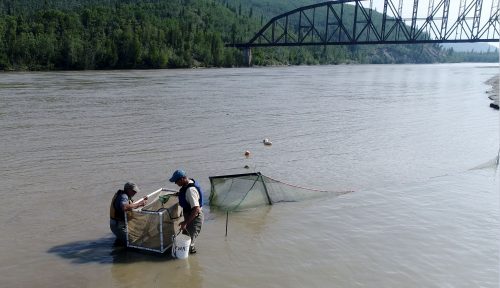Triton fish collision risk research on Tanana River
June 25, 2021
Understanding how fish interact with hydrokinetic devices is an important step in
moving the river-based renewable energy systems toward more widespread use. Researchers
from UAF’s College of Fisheries and Ocean Sciences, ACEP’s Pacific Marine Energy Center and the Pacific Northwest National Laboratory recently worked on identifying the collision risk potential of fish at the Tanana
River test site.
ACEP’s Tanana River test site equipment deployed in the research includes a 5-kilowatt
vertical axis hydrokinetic turbine, a research barge and a net deployment barge. The
barges serve as observation platforms.
During the fieldwork, CFOS researchers deployed and monitored fyke nets to sample
young fish, while PNNL researchers deployed an acoustic camera to monitor what passed
through the turbine.
The collision risk team, led by PNNL’s Garrett Staines, researches the probability of animals interacting with moving parts of current energy
converters — like turbines. Animals, such as fish, might move too close to a current
energy converter, or water currents might overpower an animal, causing it to be swept
into a device.

CFOS researchers Andrew Seitz and Mark Evans handled the fyke nets in the Tanana River near Nenana. Their sampling found chum salmon, Chinook salmon, longnose sucker and burbot. PNNL used an acoustic camera to record interactions between the longnose sucker and the hydrokinetic turbine.
The Tanana River’s high levels of suspended sediment makes using traditional underwater cameras challenging. PNNL wanted to know whether acoustic cameras could be applied to overcome these challenges. Acoustic cameras send out acoustic signals to “paint” a virtual picture of the sound in a given location. Staines, an active acoustics technology specialist, and his team will review the data collected during the testing.
This collaboration is part of the Triton Initiative — the largest hydrokinetic and marine energy research project sponsored by the U.S. Department of Energy’s Water Power Technologies Office. Triton researches the potential environmental impacts of these renewable energy systems on marine and riverine environments.
For more information on the Tanana River test site, contact Stephanie Fisher.


